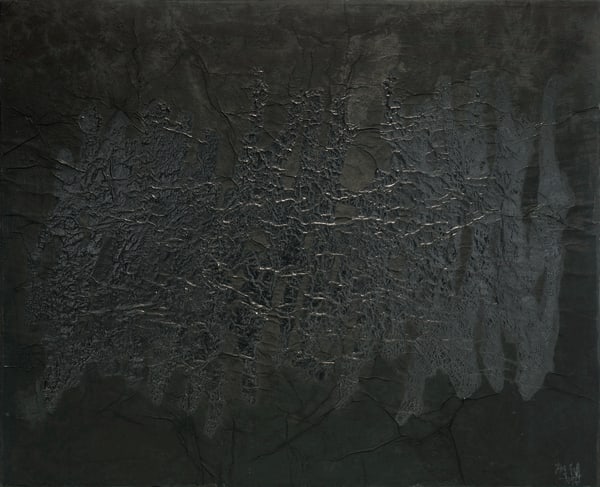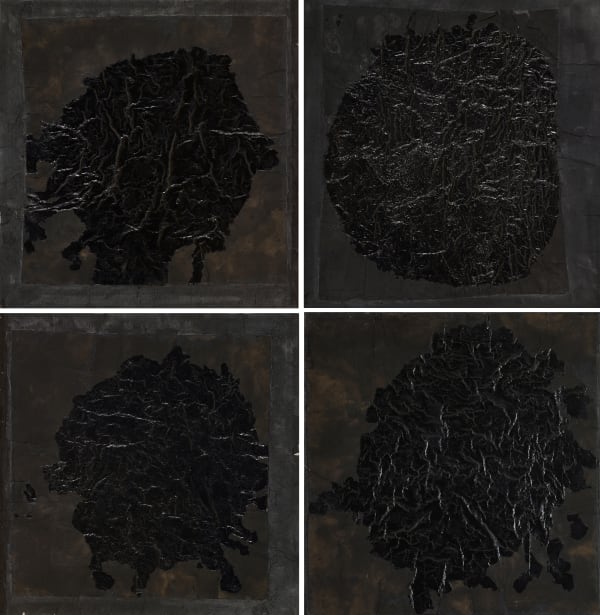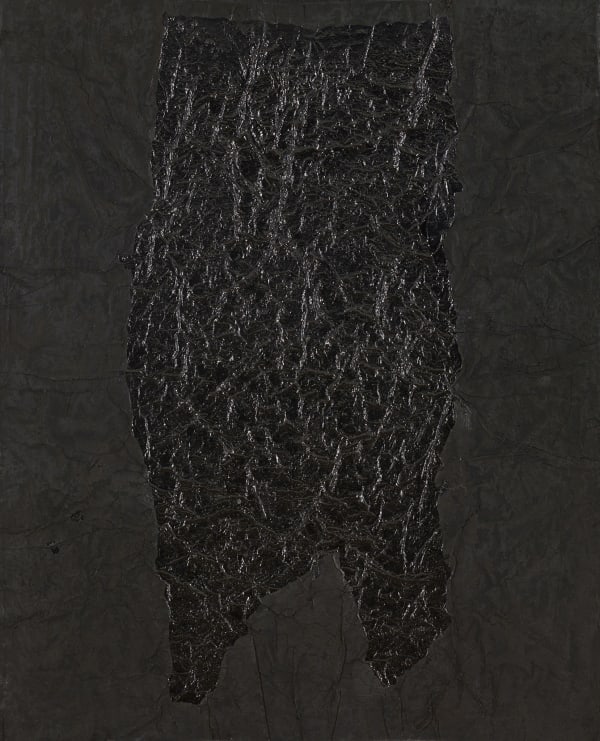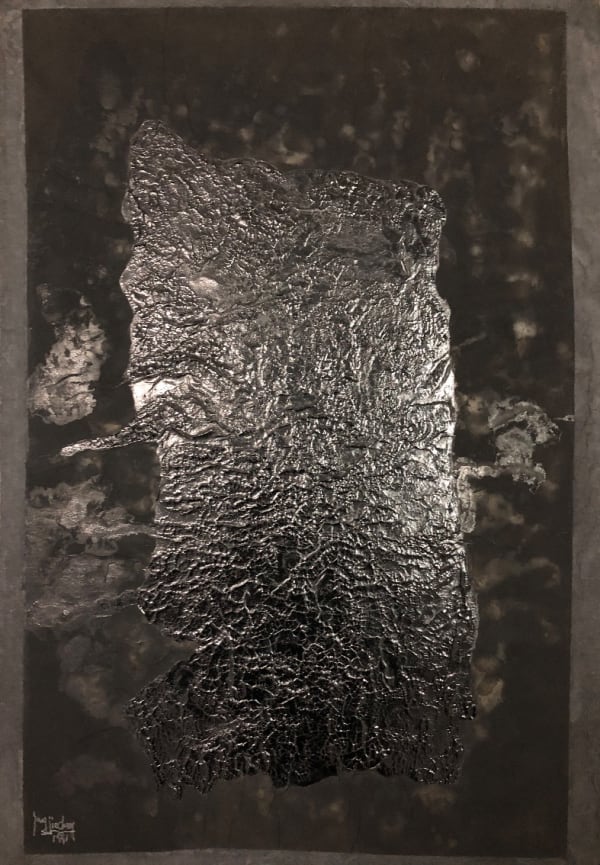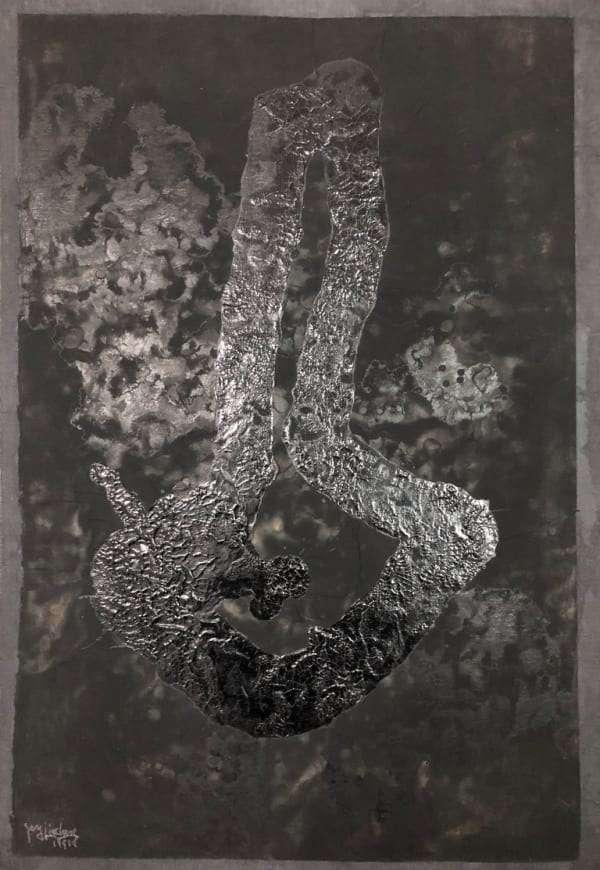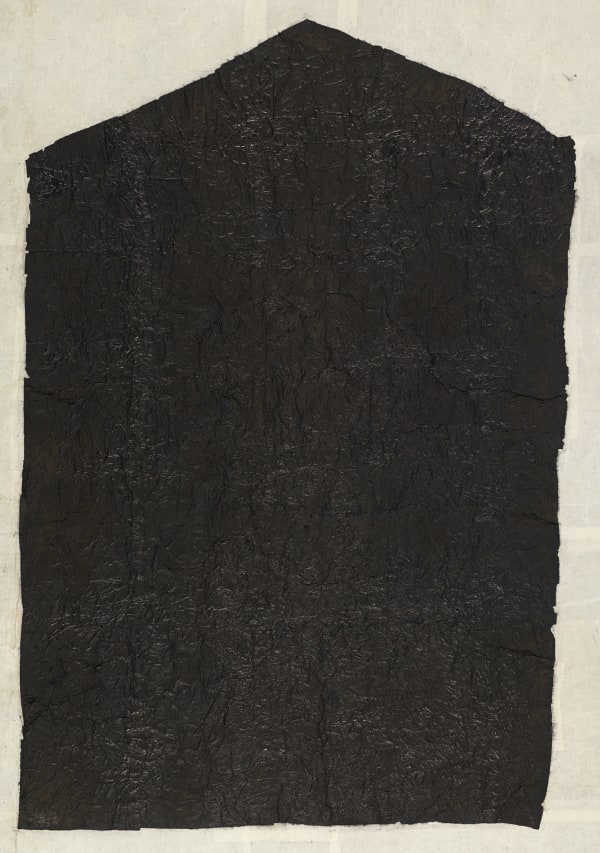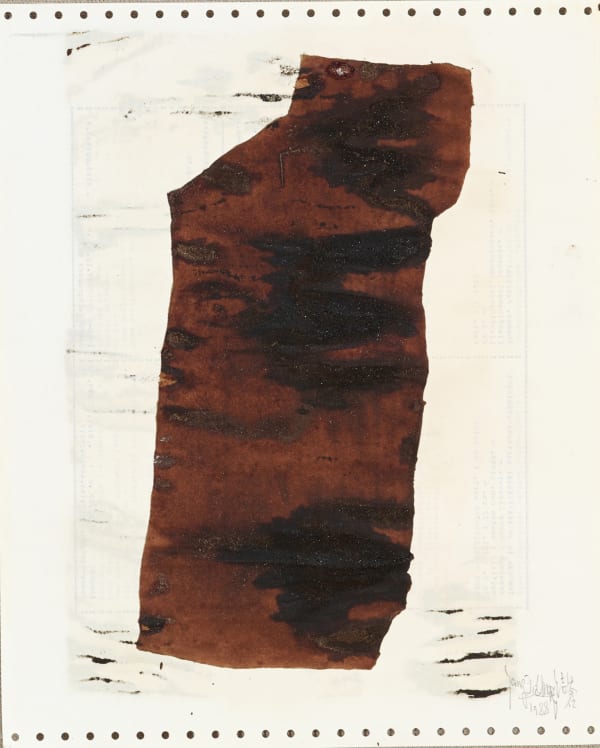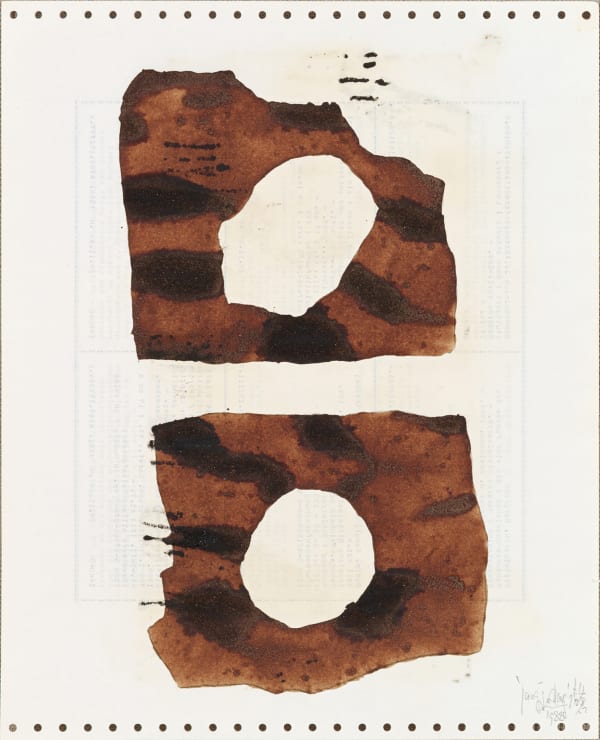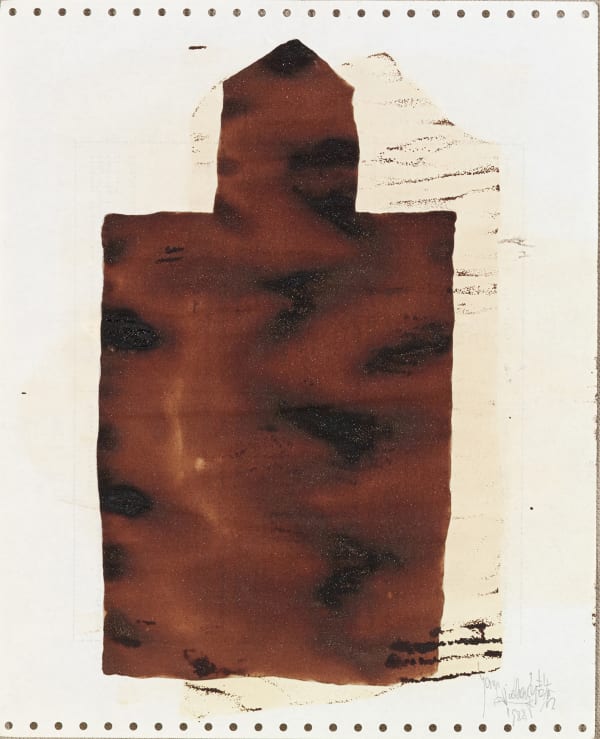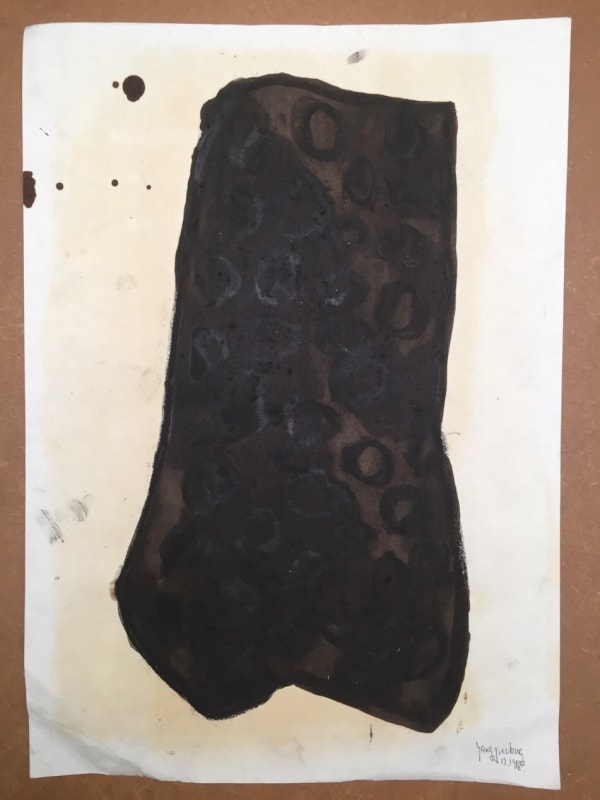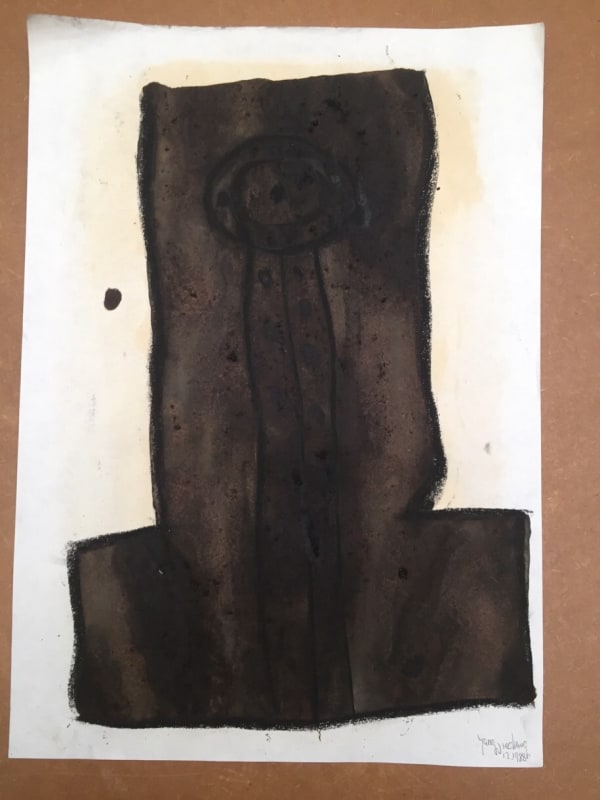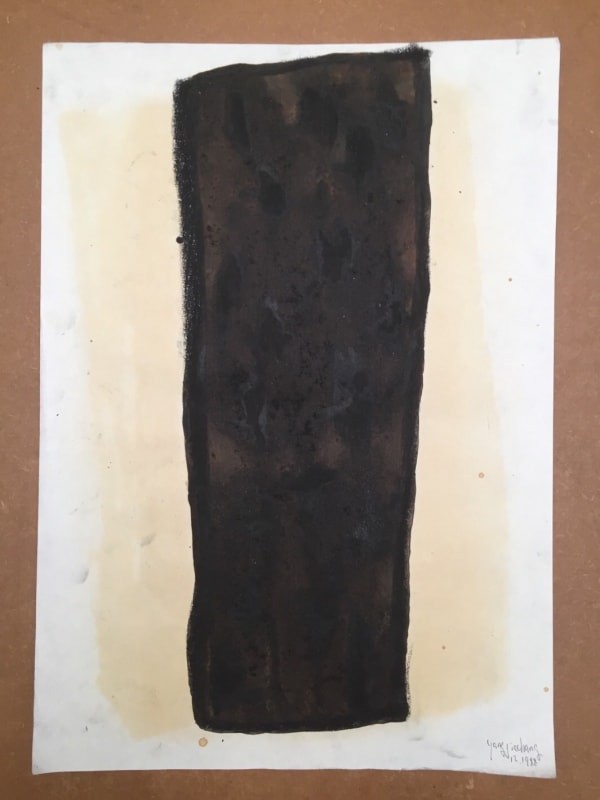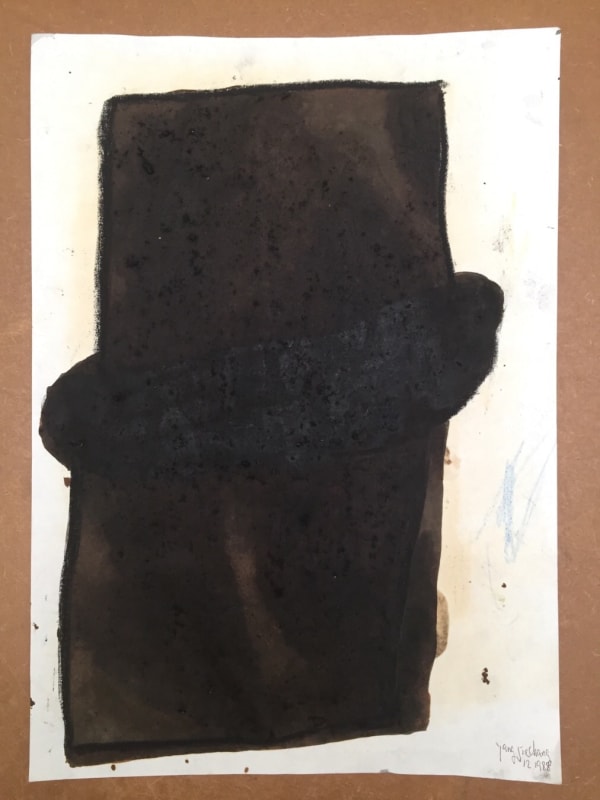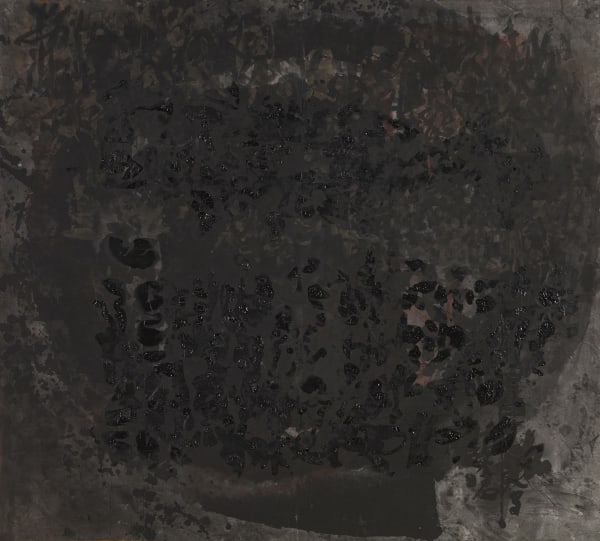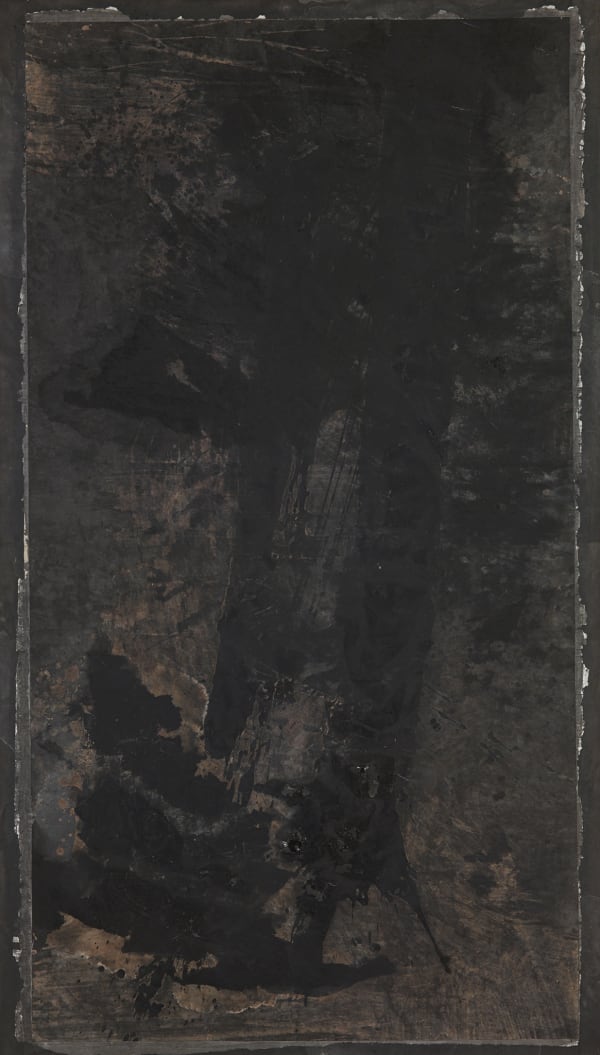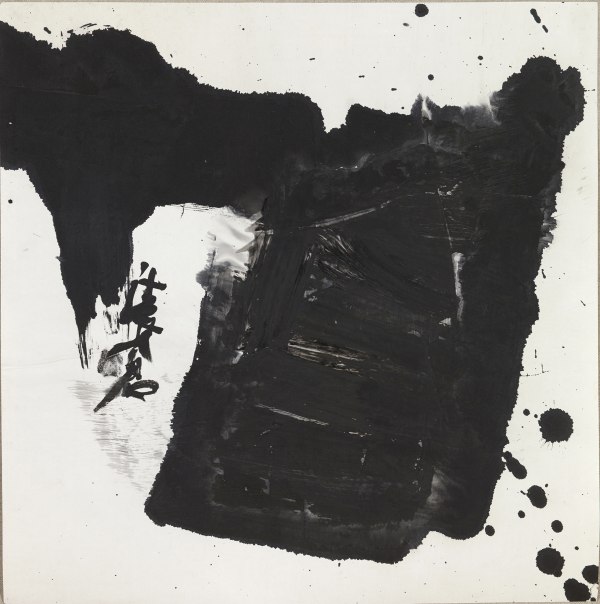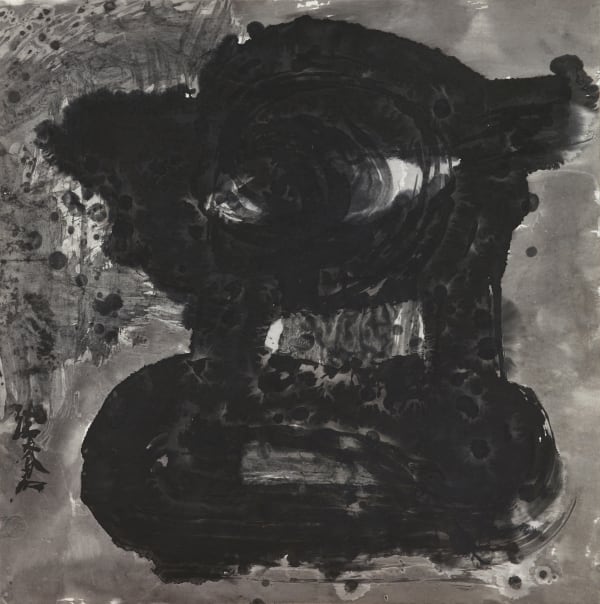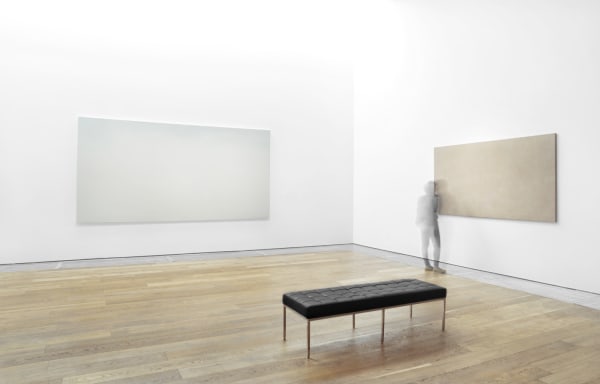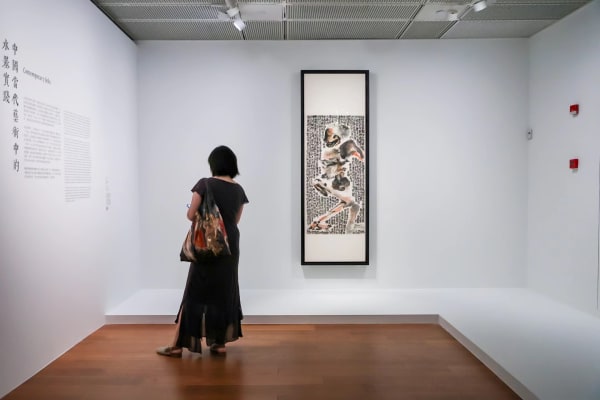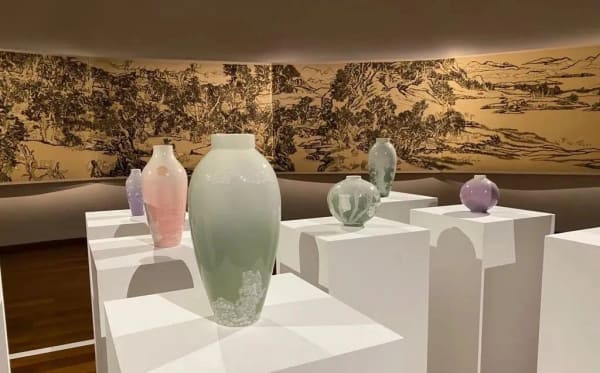b. 1956 in Foshan, Guangdong Province, China; lives and works in Paris, France, and Ittlingen, Germany
Yang Jiechang’s artistic practice as a calligrapher-painter turned global social actor inverts the contemporary Chinese art world norm of using Western avant-garde forms to critique contemporary Chinese society. He accomplishes this by adopting the performative expressivity of the traditional brush and the paradoxical dialectics of pre-modern Daoist skeptics to expose the underlying social and cultural forces that shape our contemporary global reality. Starting with his censored Massacre series in which he confronts the human toll of politically-violent authoritarian government, and continuing with his Crying Landscape series which he created for the 2003 Venice Biennale, Yang has made the critique of power, wealth, violence and terror central concerns of his artistic practice. With his purely abstract Layers of Ink works, which he inaugurated for the seminal 1989 trans-national show Magiciens de la Terre, and his figurative Ascension and Tales of the Eleventh Day series, Yang deals with the contrasting themes of material and spiritual transcendence, liberation of the individual, universal love and nature. When Yang deploys seductively masterful technique in service of psychologically disturbing or even horrifying imagery, our experience approaches the sublime—a realization of the inhuman that is both monstrous and transcendent.
Already in his student days at the Guangzhou Academy of Fine Arts where his graduation project Massacre (1982) on the devastation of the Cultural Revolution was censored, Yang Jiechang had adopted the position of provocateur. Following graduation he withdrew from art to study with Buddhist and Daoist masters. This led him to search for simplicity when he returned to painting. In 1988 he moved to Europe, where he has remained, living between Paris and a village near Heidelberg. In 1989 he participated in both the seminal Contemporary Chinese Artexhibition at the National Art Museum in Beijing and the equally paradigm-changing exhibition Les Magiciens de la Terre at the Centre Georges Pompidou where he created his artworks on site. Since then Yang has exhibition widely throughout Europe and Asia and was featured in both the China Avant-garde exhibition at the Haus der Kulturen der Welt in Berlin (1993) and in the 50th edition of the Venice Biennale (2003). In the past five years, Yang’s work has been included in numerous international exhibitions, including the Lyon Biennial (Lyon, 2009), Qui a peur des artistes? Une sélection d'oeuvres de la Fondation François Pinault (Musée de Dinard, Dinard, 2009), Hareng Saur: Ensor et Contemparain (MSK and S.M.A.K., Ghent, Belgium, 2010), The World Belongs to You (Palazzo Grassi, Fondation F. Pinault, Venice, 2011), Reactivation – Shanghai Biennale (Shanghai, 2012), Yuandao (Hong Kong Museum of Art, Hong Kong, 2013) and Ink Art: Past as Present in Contemporary China (Metropolitan Museum, New York, 2013-2014, and most recently Advance through Retreat (Rockbund Art Museum, Shanghai, 2014).
For his solo exhibition at Ink Studio in May 2014, This Is Still Landscape Painting, Yang concludes his Tales of the Eleventh Day series in which he explores the transcendence of all categories and inaugurates his latest inquiries on moral cultivation based on the paintings and sketches by a young Adolf Hitler.
In his Tales of the Eleventh Day, Yang uses the techniques of Tang dynasty Daoist and Buddhist religious mural painting to depict an imagined paradise loosely based on the setting for the Decameron, a work of fourteenth century Florentine literature by Giovanni Boccaccio. In these works, Yang depicts wild animals and naked human figures in various configurations of sexual and affectionate, cross-species coupling. Whether copulating, embracing or merely observing, it becomes clear the Yang's imagined paradise of sex and love is a non-coercive one—power dynamics and violence are completely missing. For This is Still Landscape Painting, Yang completed the final works in this series including the monumental eleven-meter, eight-panel Black and White Mustard Seed Garden (2009-2014).
In his newest series, Yang Jiechang employs the meticulous traditional Chinese brush technique of Song Dynasty court artists to copy works that Adolf Hitler painted in 1914, at age 25. In the Confucian tradition, students learn by copying their teachers brushstroke for brushstroke. In so doing, they attempt to learn not just the painting technique, but also the moral virtues of their masters. As a Daoist, however, Yang believes that only through studying evil can you understand virtue, and by examining the ugly can you find beauty. By adopting a young Hitler as his model, Yang uses artistic practice as a means to examine the nature of moral cultivation and the origins of evil. Works in the These are Still Landscapes and These are Still Flowers series are part of this new body of work.
A final dimension to Yang’s practice is his rendering of texts in response to current events in both Chinese and Roman alphabet scripts. In response to the 9/11 attack on the World Trade Center, Yang signified the shock and disbelief of the international bystander with the phrases “Oh My God” in English and “Oh Fuck” in Cantonese. Executed upside-down, Yang’s brushed lines —in both Chinese and in Roman scripts— exude a raw, expressive power based on decades of calligraphic training.
Among other places, Yang’s work can be found in the collections of Los Angeles County Museum of Art, Los Angeles; Brooklyn Museum, Brooklyn; Cantor Arts Center, Stanford University, Stanford; Berkeley Art Museum, Berkeley; The World Bank, Washington; Rockefeller Foundation, New York; Ministry of Culture, France; M+ Museum, Hong Kong; Hong Kong Museum of Art, Hong Kong; Hong Kong University Art Museum, Hong Kong; Guangdong Museum of Art, Guangzhou; Chengdu Museum of Art, Chengdu; Shenzhen Fine Art Institute, Shenzhen; Fukuoka Art Museum, Fukuoka; Sonje Museum of Contemporary Art, Kyongju, Korea; Museum for Arts and Crafts, Hamburg; Annie Wong Art Foundation, Vancouver; Swatch Collection, Switzerland; François Pinault Foundation, France; Ullens Foundation, Switzerland; Yageo Art Foundation, Taiwan; and Eslite Inc., Taiwan.
Yang is the subject of the documentary film “Yang Jiechang’s Gu and Qi,” in the series The Enduring Passion of Ink, directed and produced by Britta Erickson and filmed by Richard Widmer. Yang also is the subject of the forthcoming in-depth monograph Yang Jiechang: 道可 道非 No Way All Ways, edited by Britta Erickson and with essays by Martina Köppel-Yang and Nataline Colonello, distributed internationally by D.A.P.
-
 A Dream 梦, 1997
A Dream 梦, 1997 -
 Frequency 率, 1997
Frequency 率, 1997 -
 Operation 21.6.1969 1969年6月21日手术, 1996
Operation 21.6.1969 1969年6月21日手术, 1996 -
 Yuan 1-4 元墨1-4, 1995
Yuan 1-4 元墨1-4, 1995 -
 Hundred-Layered Square 千层方, 1994-1996
Hundred-Layered Square 千层方, 1994-1996 -
 Untitled 无题, 1994
Untitled 无题, 1994 -
 Untitled 无题, 1994
Untitled 无题, 1994 -
 For Zhang Yichao 节度张议潮, 1992-1994
For Zhang Yichao 节度张议潮, 1992-1994 -
 Ladder to Heaven 天梯, 1992
Ladder to Heaven 天梯, 1992 -
 Untitled 无题, 1992
Untitled 无题, 1992 -
 One Hundred Layers Series of Ink 千层墨系列, 1991
One Hundred Layers Series of Ink 千层墨系列, 1991 -
 One Hundred Layers Series of Ink 千层墨系列, 1991
One Hundred Layers Series of Ink 千层墨系列, 1991 -
 One Hundred Layers Series of Ink 千层墨系列, 1991
One Hundred Layers Series of Ink 千层墨系列, 1991 -
 One Hundred Layers Series of Ink 千层墨系列, 1991
One Hundred Layers Series of Ink 千层墨系列, 1991 -
 One Hundred Layers Series of Ink 千层墨系列, 1991
One Hundred Layers Series of Ink 千层墨系列, 1991 -
 One Hundred Layers Series of Ink 千层墨系列, 1991
One Hundred Layers Series of Ink 千层墨系列, 1991 -
 One Hundred Layers Series of Ink 千层墨系列, 1991
One Hundred Layers Series of Ink 千层墨系列, 1991 -
 Sun 太阳, 1991
Sun 太阳, 1991 -
 The Moon and the Sun 月 日, 1991
The Moon and the Sun 月 日, 1991 -
 One Hundred Layers of Ink 千层墨, 1990
One Hundred Layers of Ink 千层墨, 1990 -
 One Hundred Miles Squared 方百里, 1990
One Hundred Miles Squared 方百里, 1990 -
 Traveling in Mexico 墨西哥之旅, 1990
Traveling in Mexico 墨西哥之旅, 1990 -
 Traveling in Mexico 墨西哥之旅, 1990
Traveling in Mexico 墨西哥之旅, 1990 -
 A Feudal Vassal's Jade Memorial Tablet 诸侯瑹, 1989-1990
A Feudal Vassal's Jade Memorial Tablet 诸侯瑹, 1989-1990 -
 Monochrome Horizontal 黑白横, 1989-1990
Monochrome Horizontal 黑白横, 1989-1990 -
 Monochrome 黑白, 1989-1990
Monochrome 黑白, 1989-1990 -
 One Hundred Layers of Ink 千层墨, 1989
One Hundred Layers of Ink 千层墨, 1989 -
 Sketches for Les Magiciens de la Terre 大地魔术师画稿, 1989
Sketches for Les Magiciens de la Terre 大地魔术师画稿, 1989 -
 Soy Sauce Drawings 1 酱油画 1, 1988
Soy Sauce Drawings 1 酱油画 1, 1988 -
 Soy Sauce Drawings 10 酱油画 10, 1988
Soy Sauce Drawings 10 酱油画 10, 1988 -
 Soy Sauce Drawings 11 酱油画 11, 1988
Soy Sauce Drawings 11 酱油画 11, 1988 -
 Soy Sauce Drawings 12 酱油画 12, 1988
Soy Sauce Drawings 12 酱油画 12, 1988 -
 Soy Sauce Drawings 2 酱油画 2, 1988
Soy Sauce Drawings 2 酱油画 2, 1988 -
 Soy Sauce Drawings 3 酱油画 3, 1988
Soy Sauce Drawings 3 酱油画 3, 1988 -
 Soy Sauce Drawings 4 酱油画 4, 1988
Soy Sauce Drawings 4 酱油画 4, 1988 -
 Soy Sauce Drawings 5 酱油画 5, 1988
Soy Sauce Drawings 5 酱油画 5, 1988 -
 Soy Sauce Drawings 7 酱油画 7, 1988
Soy Sauce Drawings 7 酱油画 7, 1988 -
 Soy Sauce Drawings 8 酱油画 8, 1988
Soy Sauce Drawings 8 酱油画 8, 1988 -
 Soy Sauce Drawings 9 酱油画 9, 1988
Soy Sauce Drawings 9 酱油画 9, 1988 -
 Soy Sauce Paintings 1/14 酱油素描 1/14 , 1988
Soy Sauce Paintings 1/14 酱油素描 1/14 , 1988 -
 Soy Sauce Paintings 10/14 酱油素描 10/14 , 1988
Soy Sauce Paintings 10/14 酱油素描 10/14 , 1988 -
 Soy Sauce Paintings 11/14 酱油素描 11/14 , 1988
Soy Sauce Paintings 11/14 酱油素描 11/14 , 1988 -
 Soy Sauce Paintings 12/14 酱油素描 12/14 , 1988
Soy Sauce Paintings 12/14 酱油素描 12/14 , 1988 -
 Soy Sauce Paintings 13/14 酱油素描 13/14 , 1988
Soy Sauce Paintings 13/14 酱油素描 13/14 , 1988 -
 Soy Sauce Paintings 14/14 酱油素描 14/14 , 1988
Soy Sauce Paintings 14/14 酱油素描 14/14 , 1988 -
 Soy Sauce Paintings 2/14 酱油素描 2/14 , 1988
Soy Sauce Paintings 2/14 酱油素描 2/14 , 1988 -
 Soy Sauce Paintings 3/14 酱油素描 3/14 , 1988
Soy Sauce Paintings 3/14 酱油素描 3/14 , 1988 -
 Soy Sauce Paintings 4/14 酱油素描 4/14 , 1988
Soy Sauce Paintings 4/14 酱油素描 4/14 , 1988 -
 Soy Sauce Paintings 5/14 酱油素描 514 , 1988
Soy Sauce Paintings 5/14 酱油素描 514 , 1988 -
 Soy Sauce Paintings 6/14 酱油素描 6/14 , 1988
Soy Sauce Paintings 6/14 酱油素描 6/14 , 1988 -
 Soy Sauce Paintings 7/14 酱油素描 7/14 , 1988
Soy Sauce Paintings 7/14 酱油素描 7/14 , 1988 -
 Soy Sauce Paintings 8/14 酱油素描 8/14 , 1988
Soy Sauce Paintings 8/14 酱油素描 8/14 , 1988 -
 Soy Sauce Paintings 9/14 酱油素描 9/14 , 1988
Soy Sauce Paintings 9/14 酱油素描 9/14 , 1988 -
 Soy Sauce Paintings 酱油素描, 1988
Soy Sauce Paintings 酱油素描, 1988 -
 Ask the Sky 天问, 1987
Ask the Sky 天问, 1987 -
 The Way Possible and Impossible 可非道, 1987
The Way Possible and Impossible 可非道, 1987 -
 One Hundred Layers of Calligraphy 千遍书, 1986
One Hundred Layers of Calligraphy 千遍书, 1986 -
 Untitled 无题, 1986
Untitled 无题, 1986 -
 Untitled 无题, 1986
Untitled 无题, 1986 -
 Net 网, 1984
Net 网, 1984 -
 The Wind Rises as the Sun Sets 风生白下, 1984
The Wind Rises as the Sun Sets 风生白下, 1984 -
 Untitled 无题, 1983
Untitled 无题, 1983 -
 Untitled 无题, 1983
Untitled 无题, 1983 -
 Untitled 无题, 1983
Untitled 无题, 1983 -
 Untitled 无题, 1983
Untitled 无题, 1983 -
 Untitled 无题, 1983
Untitled 无题, 1983 -
 Untitled 无题, 1983
Untitled 无题, 1983
-

Taipei | Contemporary Ink, Global context
Bingyi, Jeong Gwang Hee, Li Huasheng, Jennifer Wen Ma, Wang Tiande, Yang Jiechang, Zheng Chonbin 18 - 24 Oct 2023Virtual Exhibition INKstudio is delighted to present the exhibition 'Global Ink, Contemporary Contexts' in Taipei. INKstudio selected seven artists based in various regions across continents, including Western Europe, the United...Read more -

Global INK: INKstudio’s Ten Year Anniversary Exhibition
Bingyi, Chen Haiyan, Huang Chih-yang, Li Jin, Li Huasheng, Liu Dan, Peng Kang-long, Wang Dongling, Wang Tiande, Xu Bing, Yang Jiechang, Zheng Chongbin 17 Jun - 29 Jul 2023The current exhibition, Global INK, is our opportunity to share with everyone what we have discovered over our first decade of programming. It is not a group show but instead a special exhibition consisting of twelve separate solo presentations by twelve artists who we believe define the new global contemporary INK.Read more -

Earth Roots
Yang Jiechang 10 Jun - 12 Aug 2017Earth Roots, the first systematic survey of Yang Jiechang's influential One Hundred Layers of Ink series, traces its formation and evolution from the 1980's through the 1990's.Read more -

Ink and the Mind
Ink and phenomenology. Exhibition No.2 19 Mar - 12 May 2016Ink and the Mind explores the myriad connections between ink painting and cognition, perception, affect, and imagination.Read more -

INK AND THE BODY
Ink and Phenomenology, Exhibition No. 1 21 Sep - 15 Nov 2014Ink Studio’s premier group show, Ink and the Body , launches a planned series of three exhibitions examining ink painting in terms of the relationship between the subject and both...Read more -

THIS IS STILL LANDSCAPE PAINTING
YANG JIECHANG 18 May - 31 Aug 2014This Is Still Landscape Painting features new works by artist Yang Jiechang (b. 1956 in Foshan, Guangdong province, China). With this exhibition, Yang presents his audience with a range of...Read more
-

Exhibition | Li Jin, Wang Tiande, Wei Ligang & Yang Jiechang at "Journey of Ink: Modern and Contemporary Chinese Painting from Musée Cernuschi"
October 9, 2024Journey of Ink: Modern and Contemporary Chinese Painting from Musée Cernuschi 6 Sep 2024 - 5 Jan 2025 Bund One Art Museum, Shanghai The Musée...Read more -

Exhibition | Yang Jiechang: Hundred layers of Ink — Chine demain pour hier, M+
September 27, 2024Yang Jiechang: Hundred Layers of Ink —— Chine demain pour hier 9 Oct 2024 - 24 May 2025 M+ Museum, Hong Kong Hundred Layers of...Read more -

Exhibition | Yang Jiechang, Xu Bing at "Shanshui: Echoes and Signals", M+
January 24, 2024Shanshui: Echoes and Signals 2024, 2.4 - 2026, 2.1 South Galleries, M+ Shanshui: Echoes and Signals is a thematic exhibition of works drawn from the M+ Collections...Read more -

Exhibition | Yang Jiechang at "Tales of the South", He Art Museum
December 28, 2023Tales of the South Date: 2023,12.19 - 2024,04.07 Venue: He Art Museum 6 Yixing Rd., Beijiao New Town, Shunde, Guangdong, China The complex situation of...Read more -

Li Huasheng, Yang Jiechang, He Yunchang at Mingyuan Museum of Art
November 4, 2023Getting Righteousness and Formlessness -- Abstract Narratives of Instantaneous Perception Date: 11.5, 2023-1.28, 2024 Curator: Zhang Yu Academic Chair: Gao Minglu Venue: Shanghai Mingyuan Museum...Read more -

Time Gravity - 2023 Chengdu Biennale|He Yunchang, Li Huasheng, Wang Dongling, Wang Tiande, Xu Bing, Yang Jiechang, Zheng Chongbin
August 12, 2023Time Gravity - 2023 Chengdu Biennale Date: July 16–November, 2023 Venue: Area A and B of Chengdu Art Museum in Tianfu Art Park, Chengdu (Chengdu...Read more -

Exhibition | Yang Jiechang at Museum of Wu
March 28, 2023The Quill Is Mightier Than the Sword: A Duo Exhibition by Liang Shaoji and Yang Jiechang 02.17-06.11, 2023 2/F, Museum of Wu No.9 Tantai Street,...Read more -
Exhibition | Carte Blanche à Yang Jiechang
November 15, 2022Carte Blanche à Yang Jiechang 06.07.2022 - 24.10.2022 Musée National des Arts Asiatiques - Guimet, Paris, France For its new contemporary carte blanche, the Musée...Read more -

Opening Oct 23|The Inauguration of Blanc International Contemporary Art Space
October 20, 2021Exhibition Period October 23, 2021 - January 23, 2022 (Closed on Mondays, opening on holidays) Public opening hours: 10:00-18:00 Blanc International Contemporary Art Space, Building...Read more -

Exhibition | CHINA NOW: NEW LITERATI ART (New York's Asia Week)
March 1, 2017INK studio, the critically-acclaimed Beijing-based art gallery, is pleased to announce China Now: New Literati Art , its inaugural group exhibition in the United States....Read more -

Art Fair | He Yunchang, Tao Aimin, and Yang Jiechang at Art021
November 19, 2015At Art021 2015 in Shanghai, INK studio will present works by three highly experimental artists: He Yunchang, Tao Aimin, and Yang Jiechang. Each of them...Read more -

Exhibition | Fragmentary Narratives: Fang Lijun, Xie Xiaoze, Yang Jiechang, and Yang Shaobin
October 9, 2015The group exhibition Fragmentary Narratives explores the fragmentary nature of historical narratives in the works of Fang Lijun, Xie Xiaoze, Yang Jiechang, and Yang Shaobin....Read more -
Art Fair | Yang Jiechang at China International Gallery Exposition (CIGE)
October 3, 2015Yang Jiechang's new series These are still Nude Paintings will be on view at INK studio's booth (B35) at the China International Gallery Exposition (CIGE),...Read more -

EXHIBITION | YANG JIECHANG: GOOD MORNING HONG KONG
May 16, 2015As the world is increasingly in the grips of mass hysteria, Yang Jiechang brings auspicious images to Hong Kong with the solo exhibition 'Good Morning...Read more -

EXHIBITION | Extension of Yang Jiechang’s exhibition at Ink Studio
August 6, 2014Important notice: exhibition extension until August 31, 2014 Since its opening on May 18, 2014, Yang Jiechang's current exhibition This Is Still Landscape Painting at...Read more
-

2023 Gallery Weekend Beijing | Global INK: INKstudio’s Ten Year Anniversary Exhibition
June 30, 2023Read more -

Black Alchemy: An Interview with Yang Jiechang
June 15, 2017Conducted, recorded, and edited by Alan Yeung.Read more -

The Enduring Passion for Ink: A Project on Contemporary Ink Painters
Britta Erickson February 7, 2017The Enduring Passion for Ink: A Project on Contemporary Ink Painters (or the 'Project') is a proposed exhibition, book, and film series designed to introduce...Read more -

Ink is Difficult
July 24, 2015A conversation between artist Yang Jiechang, curator and critic Martina Köppel-Yang, and Anthony Yung, Senior Researcher, Asia Art Archive at the opening of Yang Jiechang's...Read more -
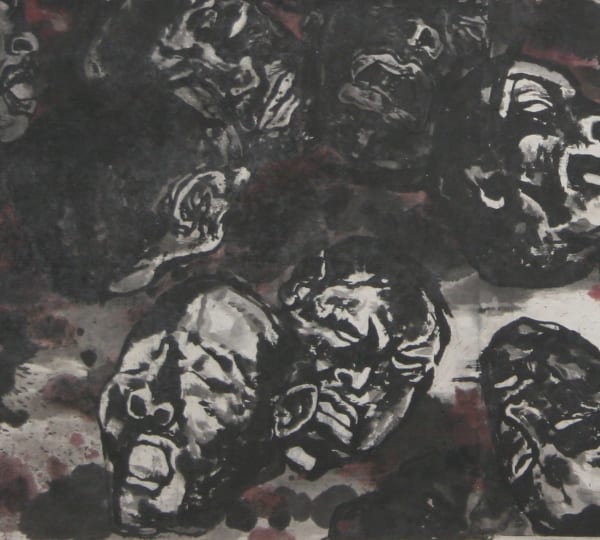
Love and Massacre in the Real World
April 3, 2015Artist Yang Jiechang tells the stories behind his early paintings Massacre (1982) and Three Men Walking (1987) and his transition from figuration to abstraction in...Read more
-

Britta Erickson on Yang Jiechang
-

A Conversation with Yang Jiechang on "Good Morning Hong Kong"
Martina Köppel-Yang -

Ink and the Body: A Phenomenological Approach
Amjad Majid -

Reinterpreting Omens: Castle Utopia and Cranes of Good Omen
Martina Köppel-Yang -

Love and Massacre in the Real World (Video Interview)
Yang Jiechang


